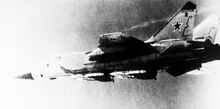
The Mikoyan MiG-31 (Russian: Микоян МиГ-31; Allied reporting name: Foxhound) is a supersonic interceptor aircraft developed to replace the MiG-25 "Foxbat". The MiG-31 was designed by the Mikoyan design bureau based on the MiG-25. Like the MiG-25, MiG-31 is a large twin-engine aircraft with side-mounted air intakes, a shoulder-mounted wing with an aspect ratio of 2.94, and twin vertical tailfins. Unlike the MiG-25, it has two seats, with the rear occupied by a dedicated weapon systems officer. The most capable air defence interceptor aircraft, the FOXHOUND has a multiple-target engagement capability and was the first fighter to have a true look-down, shoot-down capability. The N007 Zaslon radar was the first electronically scanned phased array radar to enter service in the world. It could scan 200 km forward and track 10 targets simultaneously. This radar could also track and engage target flying behind and below the aircraft. The Zaslon antenna is of the fixed type, instead of being mechanically directed the radar beam is moved electronically. This allows the full fuselage diameter to be used for the antenna, a considerable advantage since antenna diameter and effective operating range are directly related. Electronic steering of the radar beam is faster than can be performed mechanically, and it is also more accurate. All signal processing is digital. As of now, the Foxhound is in under the hands of the Axis of Empires (the Axis uses the MiG-31B variant) and the Coalition of Independent States. The most well-known Foxhound squadrons are the Axis 105th Interceptor Group and the Horde's 552nd Night Fighter Squadron.The Pact of Revolutionary Civilzations also used the MIG-31 during the second multiverse war as a main form of it's air force.
Armament

MiG-31 armed with R-33 missiles
The MiG-31's main armament is four R-33 air-to-air missiles (NATO codename AA-9 'Amos') carried under the belly. The R-33 is the Russian equivalent of the U.S. Navy's AIM-54 Phoenix.
- 1× GSh-6-23 23 mm cannon with 260 rounds.
- Fuselage recesses for 4× R-33 (AA-9 'Amos') or 6x R-37 (AA-13 'Arrow') (MiG-31M/BM only).
- 4 underwing pylons for a combination of (6 places for charging[45] (+ 2 space to add removable fuel tanks[15])):
- 6× R-37 (missile) long-range missiles (280 km).[46]
- (4[14])× R-33 (missile) long-range missiles (304 km) 2012.[47]
- (?)× Kh-31 long-range missiles (200 km) for high-speed target (maneuvering with overload 8G).[47]
- (?)× Р-33 AA-9 «Amos» (1981) 120 km, Р-33S (1999) 160 km.[48]
- 2[14] 4 (superior limit)[49]× R-40TD1 (AA-6 'Acrid')
medium-range missiles (P-40 (50 km, MiG-25P, 1970) 80 km(PD)(user)), height applications between 0.5 and 30 km (manoeuvring with overload 4 g).[50]
- 4× R-60 (AA-8 'Aphid')
- 4× R-73 (AA-11 'Archer') short-range IR missiles,
- 4× R-77 (AA-12 'Adder') medium-range missiles (100км) for high-speed target (manoeuvring with overload 12G).[51]
- 4× R-60 (AA-8 'Aphid')
- Some aircraft are equipped to launch the Kh-31P (AS-17 'Krypton') and Kh-58 (AS-11 'Kilter') anti-radiation missiles in the Suppression of Enemy Air Defences (SEAD) role.
Users
Axis of Empires
- Soviet Union(axis)
- Haqqislam
- Klingon Empire
- Federation of Americas
- People's Republic of China
- North Korea
- People's Republic of Ionia
- Yuktobania
Coalition of Independent States
- Orks
- KVA
- Combined Army
- Son'a
- Scryah Republic
- New Batarian Empire
- Klingon Rebels
- Narn Empire
- Fourth Reich
- Pagan's Royal Army
- Zann Consortium
Independent
Pact of Revolutionary Civilizations
- Kingdom of Khador
- Socialist Canadian Empire
- United Technocracies of Man
- Red Line
- Red Faction
- Estovakia
